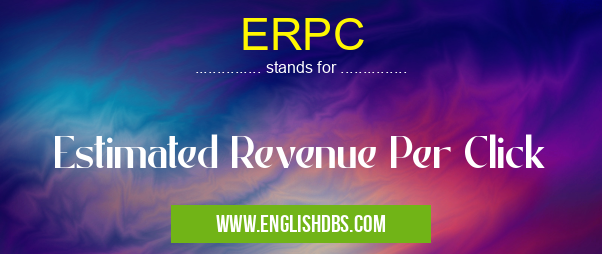What does ERPC mean in ADVERTISING
Estimated Revenue Per Click (ERPC) is a metric used in the analysis of online advertising campaigns. It reflects the expected income generated by a single click on an advertisement or link, and can therefore be used to measure the potential success of different marketing initiatives. ERPC can be used to compare different types of ads and analyze how effective they are in producing revenue for an organization. By understanding how much money each click will bring in, organizations can better optimize their campaigns and make sure that their marketing budgets are spent in a way that maximizes both clicks and ROI.

ERPC meaning in Advertising in Business
ERPC mostly used in an acronym Advertising in Category Business that means Estimated Revenue Per Click
Shorthand: ERPC,
Full Form: Estimated Revenue Per Click
For more information of "Estimated Revenue Per Click", see the section below.
» Business » Advertising
What Does ERPC Stand For?
ERPC stands for Estimated Revenue Per Click. This metric is often found alongside other metrics such as Cost Per Click (CPC), Cost Per Impression (CPM), and Return on Investment (ROI). These metrics are used together to measure the performance of online advertising campaigns from a financial perspective, and help organizations make decisions on which tactics to use, how much money to spend, and where best to invest their advertising budget.
How Is ERPC Calculated:ERPC is calculated by dividing the total estimated revenue generated by a campaign by the total number of clicks it has received. This calculation gives marketers an idea of how much money they could expect from each individual click on their ad or link. It's important for marketers to understand this figure, as it will directly impact their ROI when compared with other cost metrics such as CPC and CPM.
Benefits Of Using ERPC:The primary benefit of using ERPC is its ability to give marketers insight into what kind of return they can expect from each individual click on their ads or links. This helps them decide where best to invest their budget, which ad formats work best for them, and which tactics lead to higher ROI numbers overall. In addition, tracking ERPC over time also allows organizations to identify trends in their marketing performance, enabling them to tweak campaigns accordingly and ensure maximum efficiency with minimal waste of resources.
Conclusion:Estimated Revenue Per Click (ERPC) provides valuable insight into the financial effectiveness of online advertising campaigns by measuring the expected revenue generated per click on an ad or link. With a clear understanding of this metric, organizations can adjust their strategies accordingly and optimize campaigns for high returns while reducing wastefulness with minimal costs involved.
Essential Questions and Answers on Estimated Revenue Per Click in "BUSINESS»ADVERTISING"
What is ERPC?
ERPC stands for Estimated Revenue Per Click and it is a metric used to measure the estimated return on investment (ROI) from online marketing initiatives such as paid search ads or email campaigns. It is calculated by dividing the total estimated revenue generated from a set of clicks with the total number of clicks within that set.
What are the benefits of tracking ERPC?
Tracking ERPC can help companies determine where their best ROI lies. By identifying which campaigns are generating the most income per click, companies can optimize their online marketing strategies and allocate budgets more efficiently to get the most bang for their buck.
How can I calculate ERPC?
To calculate ERPC, you need to divide the estimated revenue generated from a set of clicks by the total number of clicks within that set. The resulting value will give you your Estimated Revenue Per Click (ERPC).
How does ERPC compare to other metrics?
Compared to other metrics such as cost per click (CPC), click through rate (CTR), and conversion rate, ERPC allows businesses to better understand how their online marketing efforts are performing from an ROI perspective.
What other factors should be considered when measuring ERPC?
While ERPC can be a helpful metric in evaluating ROI, it’s important to consider other factors that may impact your results, such as targeting accuracy, budget allocation, timing, and creative assets used in campaigns. Additionally, understanding market trends and customer preferences can also help companies drive more accurate estimates for their expected return on investment from each campaign they launch.
Do all businesses track ERIC?
Not necessarily - while tracking ERIC can be beneficial in optimizing online marketing campaigns and increasing ROI, some businesses choose not to do so due to time constraints or difficulty in calculating these estimates accurately.
Are there any risks associated with tracking ERIC?
As with any metric, relying solely on one form of measurement may lead to inaccurate conclusions about performance or profitability. Additionally, if expectations are too high based on estimations made from ERIC calculations then this could result in disappointment or overspending if actual results don’t match up with predictions.
Can I use automated tools to track my company's ERIC?
Yes - there are many automated tools available that allow businesses to easily track their Estimated Revenue Per Click (ERIC) and other key performance indicators without manual calculation or data entry. This makes monitoring your ROI easier and more efficient than ever before!
Are there any best practices for optimizing my company's ERIC?
Some of the best practices for optimizing your company’s Estimated Revenue Per Click include improving targeting accuracy, creating compelling creative assets for campaigns, testing out different timing windows for promotions, allocating appropriate budgets based on expected returns estimated using existing data sets — as well as staying up-to-date on market trends and customer preferences.
